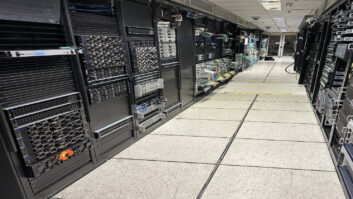
While industries such as banking and telecommunications have long relied on IP networks to transport data within their organisations, the professional broadcast industry has been far less trusting of the technology. Long-standing fears such as a lack of control and end-to-end quality, coupled with concerns about security have meant that some broadcasters have preferred to work around their existing coaxial-based SDI networks. However the drive to cut costs, deliver more and varying types of content, coupled with bandwidth concerns are pushing even skeptics to embrace IP infrastructures. The reality is that tremendous technology advancements have gone a long way toward eliminating concerns over quality and control. Adopting proven IT practices and deploying IP technologies are proving to be the best route to long-term success and future revenue opportunities.
While IP’s packetised structure was originally designed as a best-effort transport, it can be enhanced with new technologies, such as the implementation of security measures and management and control systems built on top of the IP network for end-to-end quality and uptimes. Further, IP infrastructure technologies enable dynamic, realtime transport of professional audio and images. While SDI technology reaches its limits around 4K, IP has shown that one standard can be used to move signals from just a few Kbit/s to 10G and even higher with the new 40G and 100G interfaces now available. However, due to the complexity of both what is being transported, and the network that is transporting it, it is vital to ensure that the infrastructure is carefully designed so that it is flexible enough to overcome the inevitable pitfalls.
More functionality, better protection
A considerable share of IP solutions in the professional video realm consist of simple networks such as studio-to-transmitter links. IP’s technology allows easy and reliable connections, and when combined with Ethernet, is a universal solution for very small systems to large, complex networks. IP networks are scalable, cost-effective, inherently flexible and available at a range of bandwidths, including 10Mbps, 100Mbps, 1Gbps and 10Gbps. Yet, in the broadcast world, IT/IP processes/signal transport must be highly protected and securely managed.
The newest technologies, such as the universal IP access module, integrate signal transport, universal IP/IT switching, control and management from a unified interface, delivering on the early promise of efficient, low-cost transport with the ability to control service quality and manage the content workflow along every step of the chain. This type of technology increases the availability of media networks over IP, delivering quality, flexibility and end-to-end video stream protection, while solving the uncertainty of IP networks’ lack of guaranteed quality, uptime, latency and packet loss. Protection schemes include Forward Error Correction (FEC) according to SMPTE 2022-1 for transport streaming, as well as diverse path routing and protection switching, and encoder protection provide the highest possible QoS and minimise the effects of random packet losses, burst packet losses, losses due to fast re-routes, and link failures that can be associated with IP video transport.
Of course, end-to-end network management is required to prevent overflow by securing sufficient capacity for the media and to support controlled re-routing.
Unleash the benefits
The advantages of IP extend beyond operational expense (OPEX) and capital expense (CAPEX) savings. Once broadcast services are managed within the IP domain, broadcasters can transform production, post production, contribution, and distribution of core professional video and audio assets. The ability to share these assets quickly and efficiently on a shared IP network infrastructure can unleash unprecedented collaboration, efficiency and agility throughout the entire broadcast value chain and enable the rapid introduction of new services, including HD video and content delivery over multiple platforms.
Moreover IP lends itself to today’s highly connected world where revenue opportunities will be increasingly driven by content delivery to connected/second screens such as tablets, laptops and mobile phones.
A case for education
If there’s any moral to the story of rising IP adoption, it’s that broadcasters must have basic knowledge of how IP networks function, especially when securing bandwidth through service provider networks. Broadcasters need to understand how their needs fit with established IP service parameters and translate those needs into concrete SLAs to ensure the continued high-quality service required by contribution video transport. As part of the broadcasting community, we need to ensure through careful monitoring and management that our IP networks provide the same level of guaranteed bandwidth that SDH and other legacy point-to-point connectivity provides — as well as the new benefits it brings. It all starts with being educated and knowing what to look for and how to get it.
Economies of scale, built-in flexibility, lower network operating and capital costs, increased flexibility, and the ability to push more content/increased bandwidth are among IP’s most compelling benefits. But perhaps even more significant is creating a reliable media network that can best serve broadcasters now and into the future.
By Thomas Heinzer (pictured), strategic projects, Nevion






